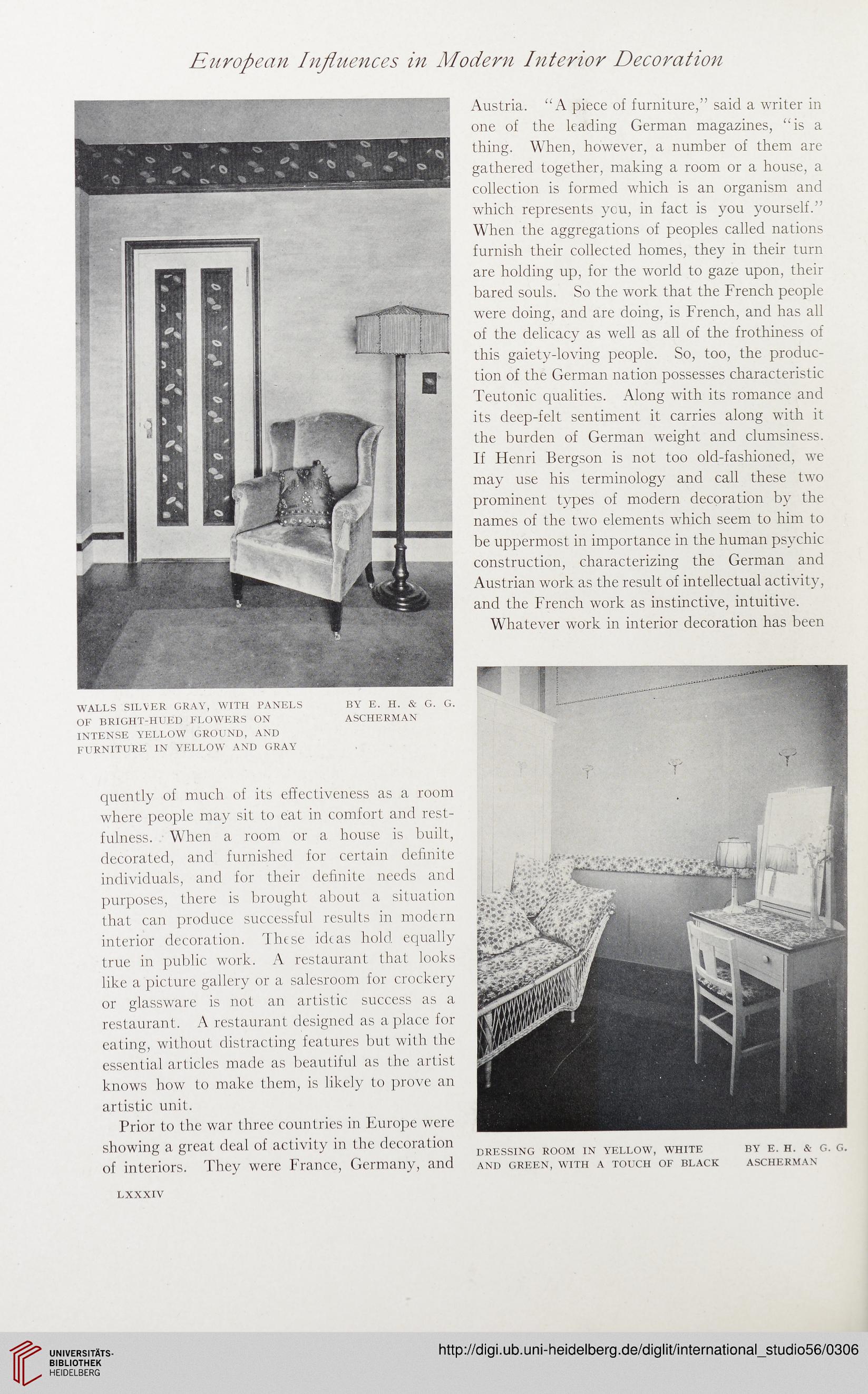European Influences in Modern Interior Decoration
WALLS SILVER GRAY, WITH PANELS
OF BRIGHT-HUED FLOWERS ON
INTENSE YELLOW GROUND, AND
FURNITURE IN YELLOW AND GRAY
BY E. H. & G. G.
ASCHERMAN
quently of much of its effectiveness as a room
where people may sit to eat in comfort and rest-
fulness. When a room or a house is built,
decorated, and furnished for certain definite
individuals, and for their definite needs and
purposes, there is brought about a situation
that can produce successful results in modern
interior decoration. These ideas hold equally
true in public work. A restaurant that looks
like a picture gallery or a salesroom for crockery
or glassware is not an artistic success as a
restaurant. A restaurant designed as a place for
eating, without distracting features but with the
essential articles made as beautiful as the artist
knows how to make them, is likely to prove an
artistic unit.
Prior to the war three countries in Europe were
showing a great deal of activity in the decoration
of interiors. They were France, Germany, and
Austria. “ A piece of furniture,” said a writer in
one of the leading German magazines, “is a
thing. When, however, a number of them are
gathered together, making a room or a house, a
collection is formed which is an organism and
which represents you, in fact is you yourself.”
When the aggregations of peoples called nations
furnish their collected homes, they in their turn
are holding up, for the world to gaze upon, their
bared souls. So the work that the French people
were doing, and are doing, is French, and has all
of the delicacy as well as all of the frothiness of
this gaiety-loving people. So, too, the produc-
tion of the German nation possesses characteristic
Teutonic qualities. Along with its romance and
its deep-felt sentiment it carries along with it
the burden of German weight and clumsiness.
If Henri Bergson is not too old-fashioned, we
may use his terminology and call these two
prominent types of modern decoration by the
names of the two elements which seem to him to
be uppermost in importance in the human psychic
construction, characterizing the German and
Austrian work as the result of intellectual activity,
and the French work as instinctive, intuitive.
Whatever work in interior decoration has been
DRESSING ROOM IN YELLOW, WHITE BY E. H. & G. G.
AND GREEN, WITH A TOUCH OF BLACK ASCHERMAN
LXXXIV
WALLS SILVER GRAY, WITH PANELS
OF BRIGHT-HUED FLOWERS ON
INTENSE YELLOW GROUND, AND
FURNITURE IN YELLOW AND GRAY
BY E. H. & G. G.
ASCHERMAN
quently of much of its effectiveness as a room
where people may sit to eat in comfort and rest-
fulness. When a room or a house is built,
decorated, and furnished for certain definite
individuals, and for their definite needs and
purposes, there is brought about a situation
that can produce successful results in modern
interior decoration. These ideas hold equally
true in public work. A restaurant that looks
like a picture gallery or a salesroom for crockery
or glassware is not an artistic success as a
restaurant. A restaurant designed as a place for
eating, without distracting features but with the
essential articles made as beautiful as the artist
knows how to make them, is likely to prove an
artistic unit.
Prior to the war three countries in Europe were
showing a great deal of activity in the decoration
of interiors. They were France, Germany, and
Austria. “ A piece of furniture,” said a writer in
one of the leading German magazines, “is a
thing. When, however, a number of them are
gathered together, making a room or a house, a
collection is formed which is an organism and
which represents you, in fact is you yourself.”
When the aggregations of peoples called nations
furnish their collected homes, they in their turn
are holding up, for the world to gaze upon, their
bared souls. So the work that the French people
were doing, and are doing, is French, and has all
of the delicacy as well as all of the frothiness of
this gaiety-loving people. So, too, the produc-
tion of the German nation possesses characteristic
Teutonic qualities. Along with its romance and
its deep-felt sentiment it carries along with it
the burden of German weight and clumsiness.
If Henri Bergson is not too old-fashioned, we
may use his terminology and call these two
prominent types of modern decoration by the
names of the two elements which seem to him to
be uppermost in importance in the human psychic
construction, characterizing the German and
Austrian work as the result of intellectual activity,
and the French work as instinctive, intuitive.
Whatever work in interior decoration has been
DRESSING ROOM IN YELLOW, WHITE BY E. H. & G. G.
AND GREEN, WITH A TOUCH OF BLACK ASCHERMAN
LXXXIV




